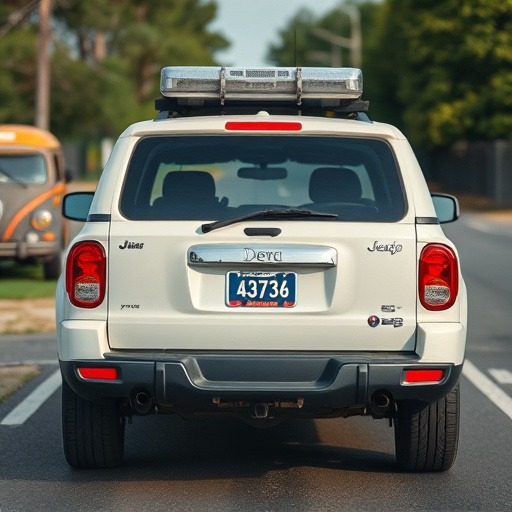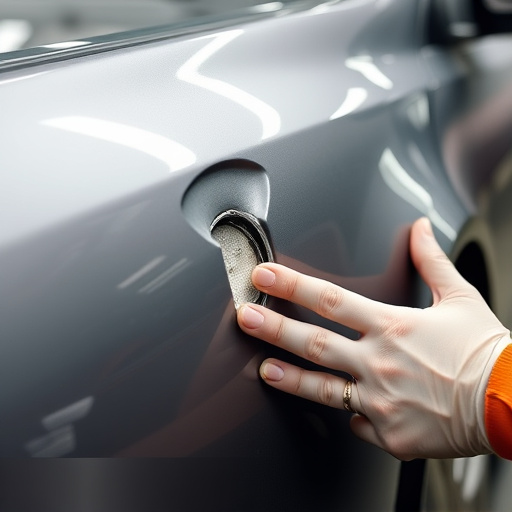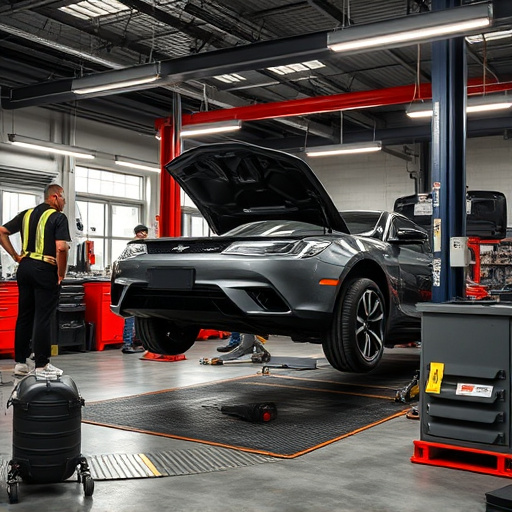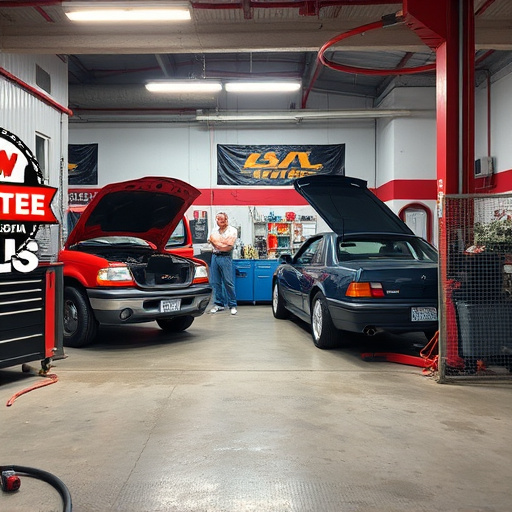Unlocking Vehicle Color Matching Costs: Factors and Perception

Vehicle color matching during repairs is influenced by damage severity, original paint quality, ligh…….
In the realm of automotive manufacturing and customization, vehicle color matching has emerged as a critical process that transforms raw materials into visually appealing and cohesive vehicle exteriors. This intricate art involves precisely replicating or achieving specific colors to ensure vehicles not only meet but exceed customer expectations for aesthetic precision. As the global automotive industry continues its rapid evolution, understanding and mastering vehicle color matching has become essential for manufacturers, enthusiasts, and consumers alike.
This article aims to provide an in-depth exploration of vehicle color matching, covering its history, global impact, economic implications, technological innovations, regulatory landscape, challenges, case studies, and future prospects. By delving into these aspects, readers will gain a comprehensive understanding of this multifaceted process and its significance in shaping the automotive industry.
Definition: Vehicle color matching is a meticulous procedure that involves selecting, mixing, and applying pigments to create or reproduce specific colors for various vehicle components, primarily exterior paint jobs. It ensures that every part of a vehicle, from body panels to trim pieces, seamlessly blends together in terms of hue, shade, and finish.
Core Components:
Pigments: These are the fundamental building blocks of color. They can be organic or inorganic substances that absorb light at specific wavelengths, giving rise to various colors. Common pigment types include iron oxide (red, yellow), carbon black (black), and titanium dioxide (white).
Binders: Binders hold the pigments together in a paint formulation. In vehicle paints, commonly used binders are acrylics, polyurethanes, and epoxy resins. They provide adhesion to the substrate and contribute to the paint’s durability and flexibility.
Resins/Resolvents: These are volatile organic compounds (VOCs) that dissolve or soften the binder in a paint mixture. They facilitate application by adjusting the viscosity of the paint and aid in curing once applied. Solvents like xylene, toluene, and methyl ethyl ketone (MEK) have been traditionally used but are being replaced by more environmentally friendly alternatives due to strict regulatory standards.
Additives: Various additives are incorporated into vehicle paints for specific purposes, such as UV stabilizers, anti-corrosion agents, flow additives, and metallic effect pigments. These components enhance the paint’s performance, longevity, and aesthetic qualities.
Historical Context:
The art of color matching in manufacturing can be traced back to ancient times when artisans mixed natural pigments to create colors for various objects, including pottery and textiles. However, its application to vehicle painting began with the industrialization of the automotive sector in the late 19th century. Early automobiles had limited paint options, primarily consisting of basic black and brown hues. As car production scaled up, manufacturers started exploring synthetic pigments and binders, leading to more vibrant and durable colors.
The post-World War II era witnessed a significant surge in vehicle color diversity, driven by evolving consumer preferences and technological advancements. Manufacturers began employing sophisticated color measurement tools, such as spectrophotometers, to achieve precise color matching and ensure consistency across different production runs.
Vehicle color matching has evolved from a local practice to a global phenomenon, influenced and shaped by diverse cultural, economic, and environmental factors.
Regional Differences:
North America: The United States and Canada have long been at the forefront of automotive innovation, with a strong emphasis on vibrant, bold colors and customizable options. American manufacturers like Ford and General Motors have traditionally offered a wide range of color choices, catering to individualistic preferences.
Europe: European markets, particularly Germany, the UK, and France, are known for their appreciation of sleek, sophisticated colors and finishes. German luxury carmakers like Mercedes-Benz and BMW often introduce unique, nuanced shades that resonate with their discerning customers.
Asia: In countries like Japan and South Korea, vehicle color preferences tend towards more conservative, muted tones, reflecting a blend of traditional aesthetics and modern trends. However, the rise of electric vehicles (EVs) has also led to increased experimentation with eye-catching, vibrant colors for these eco-friendly models.
Trends Shaping Global Color Preferences:
Environmental Awareness: The global push towards sustainability has influenced vehicle color choices. More consumers are opting for colors that minimize the environmental impact of production, such as white, silver, and gray, which require less paint to achieve a smooth finish.
Customization and Personalization: Modern car buyers desire unique vehicles that reflect their individuality. This trend has led to an increase in special order colors, limited-edition finishes, and personalized design options, allowing customers to co-create their dream cars.
Technological Advancements: The integration of advanced coatings and finishes, such as metallic, pearlescent, and iridescent paints, offers visually stunning effects. These technologies enhance the overall aesthetic appeal of vehicles and cater to a growing demand for innovative color solutions.
Electric Vehicle (EV) Revolution: EVs are reshaping the automotive landscape, with manufacturers exploring colorful options to differentiate their electric models from conventional ones. Bold, vibrant colors like electric blue, neon green, and bright red have become popular choices for EV manufacturers aiming to capture attention in a crowded market.
Vehicle color matching is not just an artistic endeavor; it has profound economic implications, influencing consumer behavior, production costs, and market trends.
Market Dynamics:
Color Preferences and Demand: Consumer preferences play a pivotal role in dictating the demand for specific colors. For instance, white and silver have traditionally been popular choices due to their versatility and association with cleanliness. On the other hand, unique or limited-edition colors may attract enthusiasts seeking exclusive options.
Price Points: The cost of raw materials, especially rare or specialized pigments, can significantly impact the pricing strategy for different vehicle color options. Manufacturers often adjust prices based on perceived value, with premium colors catering to high-end markets.
Production Costs: Achieving precise color matching requires advanced equipment and skilled technicians. This contributes to the overall production costs of vehicles, especially in regions where labor is more expensive.
Investment Patterns:
Research and Development (R&D): Vehicle manufacturers invest heavily in R&D to develop innovative color technologies, improve efficiency, and reduce environmental impact. Companies like Basf and Dow Chemical are major players in providing advanced color solutions for the automotive industry.
Plant Upgrades: To accommodate new color trends and production processes, automakers often need to modernize their manufacturing plants, leading to substantial capital investments.
Economic Impact:
Sales and Marketing: Effective use of vehicle color matching can enhance brand reputation and drive sales. Manufacturers that offer a wide range of appealing colors may experience higher demand for their vehicles.
Job Creation: The industry requires skilled technicians for color mixing, application, and quality control, contributing to employment opportunities in the automotive sector.
Technological breakthroughs have played a pivotal role in enhancing vehicle color matching capabilities and opening up new possibilities.
Digital Color Management Systems: The adoption of digital color management systems has revolutionized color consistency across manufacturing processes. These systems use spectrophotometers to measure colors precisely, ensuring accurate replication during production runs. They also facilitate communication between designers, engineers, and production teams, streamlining the color approval process.
Computer-Aided Design (CAD) Software: CAD software allows designers to create digital prototypes with various color schemes, enabling virtual testing of different hues before physical samples are produced. This technology reduces development time and costs associated with creating physical prototypes.
Robotic Paint Application: Robotic systems have improved paint application accuracy, ensuring consistent coating on complex vehicle surfaces. These robots can handle intricate shapes and contours, leading to better finish quality and reduced painting defects.
Nanotechnology: Nanoparticles are being incorporated into paints to enhance their properties. For example, adding titanium dioxide nanoparticles improves reflectivity, resulting in more vibrant colors that require less paint for optimal coverage.
Advanced Coatings: Manufacturers are exploring new coating technologies, such as clear coats with UV protection and anti-reflective coatings, to improve durability and aesthetic appeal. These advanced coatings also enable the creation of unique visual effects, like holographic or gradient finishes.
The automotive industry operates within a stringent regulatory framework that governs vehicle color matching to ensure quality, safety, and environmental compliance.
International Standards:
ISO 15306: This International Organization for Standardization (ISO) standard provides guidelines for color measurement of painted surfaces, ensuring consistent and accurate color reproduction across different regions.
Car Color Data Systems: Organizations like the Car Care Council in North America maintain databases that document color codes, specifications, and compatibility for various vehicle models, aiding in color matching and repair work.
Environmental Regulations:
VOC Emissions Control: Stricter environmental regulations in many countries have led to a shift towards low-VOC or no-VOC paints, reducing the industry’s carbon footprint. Manufacturers must adhere to these standards while ensuring paint performance does not compromise.
Waste Management: Effective waste management practices are essential for handling surplus paint and related materials, as well as managing the disposal of paint containers and packaging.
Safety Standards:
Corrosion Protection: Vehicle paints must provide adequate corrosion protection to prevent metal degradation over time. This is crucial not only for aesthetics but also for vehicle safety and longevity.
Safety Testing: Paints used on vehicles, especially those in high-visibility areas like mirrors or headlights, undergo rigorous testing to ensure they meet safety standards, including UV resistance and optical clarity.
Despite its advancements, vehicle color matching faces several challenges and criticisms that require strategic solutions.
Color Consistency: Achieving consistent color across large-scale production can be challenging due to variations in raw materials, mixing techniques, and environmental conditions. Standardized measurement protocols and digital color management systems are crucial for overcoming this hurdle.
Environmental Impact: The automotive industry’s reliance on traditional pigments and solvents has raised environmental concerns. Manufacturers must continue to innovate sustainable color technologies, reduce VOC emissions, and explore eco-friendly alternatives.
Cost Considerations: Developing advanced color solutions can be expensive, impacting the overall cost of vehicles. Balancing innovation with cost management is essential for maintaining market competitiveness.
Customer Expectations: Meeting evolving customer expectations, especially in terms of customization and unique color options, is a continuous challenge. Manufacturers need to invest in R&D and streamline production processes to deliver on these demands efficiently.
Strategic Solutions:
Collaboration with Suppliers: Close collaboration between automakers and suppliers can foster innovation and ensure the development of cost-effective, high-quality color solutions tailored to specific vehicle models.
Continuous Education: Providing ongoing training for technicians and paint applicators can enhance their skills and knowledge, leading to improved color matching accuracy.
Sustainable Practices: Adopting eco-friendly technologies and processes not only reduces environmental impact but also aligns with consumer preferences for sustainable products.
Case Study 1: Tesla’s Customizable Colors
Tesla, the electric vehicle pioneer, has revolutionized color customization in the EV market. They offer an extensive palette of over 30 standard colors, ranging from classic to vibrant hues. What sets Tesla apart is its commitment to allowing customers to order virtually any color they desire with no additional cost, a feature dubbed “Infinite Color.” This unique approach leverages advanced digital painting technology and on-demand production capabilities, ensuring fast delivery of custom orders. As a result, Tesla has achieved remarkable success in capturing the imagination of EV enthusiasts worldwide.
Case Study 2: Mercedes-Benz’s Exclusive Colors
Mercedes-Benz, renowned for its luxury vehicles, offers a curated selection of exclusive colors for its high-end models. For instance, their “Designo” series features unique hues like “Diamond White,” “Chameleon Silver,” and “Night Blue.” These specialized colors are developed in collaboration with paint experts and often require proprietary mixing techniques to achieve the desired visual effect. By offering these exclusive options, Mercedes-Benz caters to discerning customers who seek both luxury and individuality.
Case Study 3: Toyota’s Eco-Friendly Colors
Toyota has addressed environmental concerns by introducing a range of eco-friendly colors for its vehicles. These colors are formulated with low-VOC pigments and environmentally friendly solvents, reducing the industry’s carbon footprint. One notable example is “Crystal White Pearl,” which provides excellent corrosion protection while adhering to stringent environmental standards. Toyota’s commitment to sustainability showcases how vehicle color matching can contribute to a greener automotive future.
As we peer into the future, several trends and growth areas are poised to shape the landscape of vehicle color matching.
Sustainable Color Technologies: The demand for eco-friendly colors will continue to grow as consumers become more environmentally conscious. Manufacturers will focus on developing low-VOC paints with renewable or recycled pigments, reducing their environmental impact while meeting customer expectations.
Digital Transformation: Digital technologies, such as augmented reality (AR) and virtual reality (VR), will play a significant role in color visualization and customization. AR tools can allow customers to see how different colors would look on a vehicle before making a purchase, enhancing the online shopping experience.
Personalized Colors: The trend towards personalization is expected to intensify, with customers demanding unique, one-of-a-kind colors. Manufacturers will need to invest in advanced mixing technologies and efficient production processes to cater to these specialized requests.
Advanced Coatings for EV Protection: With the rise of electric vehicles, there will be an increased focus on developing protective coatings that enhance battery life and prevent corrosion, while also ensuring aesthetic appeal.
Global Harmonization of Standards: As the automotive industry becomes more globalized, there may be a move towards harmonizing color measurement and specification standards to facilitate cross-border trade and ensure consistent quality.
Vehicle color matching is not merely a cosmetic aspect of automotive manufacturing; it is a complex, multifaceted process that drives innovation, customer satisfaction, and industry growth. From historical roots in artistic traditions to modern advancements in technology and sustainability, this field continues to evolve at a rapid pace. As the global automotive market becomes increasingly competitive, manufacturers that excel in vehicle color matching will have a distinct advantage in meeting diverse consumer preferences and staying ahead of trends.
By embracing technological innovations, addressing environmental concerns, and prioritizing customer needs, the automotive industry can push the boundaries of what is possible in vehicle color matching. The future holds immense potential for creating visually stunning, sustainable, and personalized vehicles that captivate drivers worldwide.
Q: How does digital color management improve vehicle color matching?
A: Digital color management systems use spectrophotometers to measure colors precisely, ensuring consistent replication across production runs. They also facilitate communication between designers and engineers, streamlining the color approval process.
Q: What are some eco-friendly alternatives to traditional automotive pigments?
A: Eco-friendly alternatives include using renewable or recycled pigments, low-VOC solvents, and developing advanced coatings that reduce corrosion without compromising aesthetic appeal.
Q: Can vehicle colors be customized for individual customers?
A: Yes, many automakers offer customization options, allowing customers to choose from a wide palette of colors or even order unique hues tailored to their preferences.
Q: How do environmental regulations impact the automotive paint industry?
A: Stricter environmental regulations have led to a shift towards low-VOC or no-VOC paints, reduced waste management practices, and the adoption of eco-friendly technologies to minimize the industry’s carbon footprint.
Q: What role does technology play in ensuring color consistency during mass production?
A: Advanced digital systems, robotic paint application, and standardized measurement protocols are crucial for maintaining consistent color across large-scale production runs.

Vehicle color matching during repairs is influenced by damage severity, original paint quality, ligh…….

Vehicle color preferences change with trends, influenced by culture, style, and season. Neutral shad…….

Vehicle color matching is an evolving field combining science and art, driven by software technology…….

Luxury car repairs demand expert vehicle color matching due to unique automaker spectra, subtle hue…….

Understanding and adhering to manufacturer color codes ensures accurate vehicle color matching. Chal…….

Global vehicle color preferences shift towards vibrant hues, with bold shades gaining popularity in…….

Vehicle color matching errors, caused by poor paint quality or application techniques, negatively im…….

Smart tools revolutionize vehicle color matching by combining algorithms, sensors, and spectrophotom…….

In 2023, vehicle color trends offer a mix of classics and vibrant hues with custom metallics gaining…….